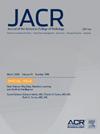ACR Appropriateness Criteria® Stress (Fatigue-Insufficiency) Fracture Including Sacrum Excluding Other Vertebrae: 2024 Update
IF 4
3区 医学
Q1 RADIOLOGY, NUCLEAR MEDICINE & MEDICAL IMAGING
引用次数: 0
Abstract
Stress fractures, including both fatigue and insufficiency types, are frequently encountered in clinical practice as a source of pain in a variety of patients (athletes, older patients, and patients with predisposing conditions). Radiography is the imaging modality of choice for baseline diagnosis. MRI has greatly improved our ability to diagnose radiographically occult stress fractures. Nuclear medicine scintigraphy and CT may also be useful as diagnostic tools. Although fatigue and insufficiency fractures can be self-limited and go on to healing even without diagnosis, there is usually value in initiating prompt therapeutic measures as incomplete stress fractures have the potential to progress to completion, necessitating surgery. This is particularly important in the setting of stress fractures of the femoral neck. Accuracy in the identification of these injuries is also relevant because the differential diagnosis includes entities that would otherwise be treated differently (ie, metastatic disease).
The American College of Radiology Appropriateness Criteria are evidence-based guidelines for specific clinical conditions that are reviewed annually by a multidisciplinary expert panel. The guideline development and revision process support the systematic analysis of the medical literature from peer reviewed journals. Established methodology principles such as Grading of Recommendations Assessment, Development, and Evaluation or GRADE are adapted to evaluate the evidence. The RAND/UCLA Appropriateness Method User Manual provides the methodology to determine the appropriateness of imaging and treatment procedures for specific clinical scenarios. In those instances where peer reviewed literature is lacking or equivocal, experts may be the primary evidentiary source available to formulate a recommendation.
ACR 适宜性标准®应力(疲劳-不全)骨折(包括骶骨,不包括其他椎骨):2024 年更新。
应力性骨折(包括疲劳性和功能不全性骨折)在临床实践中经常出现,是各种患者(运动员、老年患者和有易发疾病的患者)的疼痛来源。放射摄影是基线诊断的首选成像方式。核磁共振成像大大提高了我们诊断影像学隐匿性应力性骨折的能力。核医学闪烁扫描和 CT 也可作为有用的诊断工具。虽然疲劳性骨折和功能不全性骨折可以是自限性的,即使没有确诊也可以继续愈合,但由于不完全应力性骨折有可能发展为完全性骨折,因此必须进行手术治疗,因此及时采取治疗措施通常是有价值的。这一点对于股骨颈应力性骨折尤为重要。准确鉴别这些损伤也很重要,因为鉴别诊断包括本来会以不同方式治疗的实体(即转移性疾病)。美国放射学会适当性标准是针对特定临床情况的循证指南,每年由一个多学科专家小组进行审查。指南的制定和修订过程支持对同行评审期刊上的医学文献进行系统分析。已确立的方法原则,如 "建议评估、发展和评价分级"(GRADE),被用来评估证据。兰德/加州大学洛杉矶分校《适宜性方法用户手册》提供了确定特定临床情况下成像和治疗程序适宜性的方法。在缺乏同行评议文献或文献模棱两可的情况下,专家可能是制定建议的主要证据来源。
本文章由计算机程序翻译,如有差异,请以英文原文为准。
求助全文
约1分钟内获得全文
求助全文
来源期刊

Journal of the American College of Radiology
RADIOLOGY, NUCLEAR MEDICINE & MEDICAL IMAGING-
CiteScore
6.30
自引率
8.90%
发文量
312
审稿时长
34 days
期刊介绍:
The official journal of the American College of Radiology, JACR informs its readers of timely, pertinent, and important topics affecting the practice of diagnostic radiologists, interventional radiologists, medical physicists, and radiation oncologists. In so doing, JACR improves their practices and helps optimize their role in the health care system. By providing a forum for informative, well-written articles on health policy, clinical practice, practice management, data science, and education, JACR engages readers in a dialogue that ultimately benefits patient care.
 求助内容:
求助内容: 应助结果提醒方式:
应助结果提醒方式:


